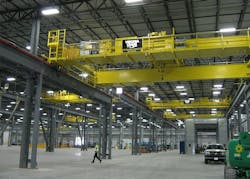Overhead gantry cranes are the workhorses inside heavy industry plants throughout the world, lifting massive loads that are either production inputs or the outputs of a plant’s manufacturing process. For example, gantry-crane applications in the metal manufacturing arena include the pouring of feedstock into furnaces or the loading of 60-ton coils onto inventory racks.
A gantry crane bridge can be as high as a six-story building and can span 100 feet or more. Given the size and scope of gantry-crane operations, collisions are a real problem. The sheer size of overhead gantry cranes and their massive loads almost ensures that accidents are never minor.
Charlotte, N.C.-based system integrator Trutegra, which specializes in crane and hoist controls, is quite familiar with these challenges in the metals industry. Through its customers, Trutegra learned that many were incurring ongoing safety issues as well as substantial maintenance and downtime costs when cranes would accidentally bump into various objects or structures as they moved along their work paths.
A typical gantry system features a trolley positioned on the bridge that runs on rails and has a massive hoist system to lift loads. Many of Trutegra’s metal industry customers use manually operated bridge cranes with rotating masts that have hoists to lift huge coils of metal.
When one customer needed a new system for a new plant it was building, Trutegra created a patent-pending, laser-guided obstacle avoidance system (OAS) to move and stack 20-ton coils. The system automated gantry-crane operations to the extent that the manufacturer reported that 98 percent of coil stacking is now done automatically.
At the heart of that system are a Siemens S7-300 PLC and Siemens Simatic Nanobox PC. The PC-based control technology, combined with mapping software and laser-guided sensors, enables 10-ton metal coils moving at 3 meters per second to know when to make a 90-degree turn into a 12-foot aisle.
Mapping the factory
The project started with the new factory being mapped in AutoCAD computer-aided design software—a four-day process. The CAD drawing was then converted into a database and the data was imported into the Obstacle Avoidance system in the form of a DXF file. It is stored on the Nanobox PC, located on the gantry bridge.
The system also includes mapping the size, shape and velocity of the crane and its load in real time. “The industrial PC is ideally suited for the factory floor application. It’s powerful, has no moving parts, is fanless, and it mounts on a DIN rail,” says Paul Vogt, vice president of R&D for Trutegra.
Trutegra uses a mix of Sick laser-enabled distance meters, encoders and other means to monitor the real-time position and velocity of the crane. For this installation, two distance meters per crane communicate wirelessly via a Profinet network to the crane’s PLC to help control the crane’s motion. Using the laser-enabled inputs, the Industrial PC’s server does the calculations to predict future collisions; it will decelerate the crane if it detects the crane is traveling along a vector that will result in a collision.
For example, one combination of variables might start slowing the crane at a distance of 20 meters, while another set might begin to intervene at half that distance. “If an operator has the crane a half a meter from an object and wants to nudge the crane a bit closer to the object, the system knows the crane is moving very slowly and has the ability to stop,” says Vogt.
The geometry gets even more complex and dynamic for the industrial PC as the crane rotates, whether it’s carrying a load or not. “The server software running on the Nanobox PC carries two sets of data, along with the direction and velocity of the crane,” Vogt says. “The system is constantly assessing all these parameters to determine whether to apply the brakes in any particular axis.”
For the plant, the production goal was seven-minute cycles per crane to move its 1- to 20-ton metal coils.
Safety systems
With wireless data moving so fast, this plant uses a safety PLC from Siemens to provide an immediate override. “When an e-stop is actuated wirelessly, we disable the safe torque off (STO) inputs on the crane to stop motion. This can happen when power to the operator’s wireless is removed,” says Vogt.
The industrial PC also has a dedicated driver communicating with the crane’s PLC and, if a connection is lost, the crane will stop. Vogt adds that this has not been an issue at the plant.
The metals manufacturer also logs all this factory floor data into a database and allows the company to see historical data via a “viewer.” This HMI functionality allows historical data to be played back as if the data stream were live. When viewing an archive, the user sees DVR-like controls (forward, reverse, fast forward, fast reverse).
The same viewer is used to view live crane activity, and/or archived historical data, and multiple viewers attach simultaneously.The client/server application is delivered as a “thick client” written in Windows Presentation Foundation (WPF), and can be installed on any MS Windows computer or laptop supporting .Net Framework 4.5, says Vogt.
About the Author
Grant Gerke
Digital Managing Editor

Leaders relevant to this article:
